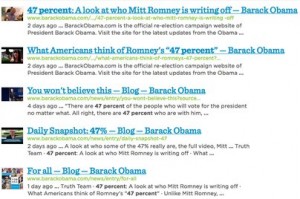Brands
The Content Battle Over Romney’s 47 Percent Remark
As part of the Content Campaign ’12 Series, The Content Strategist examines the content published by the presidential campaigns as part of their strategy to win November’s general election.
 Sometimes good content comes from the opposition. The best content can come straight from the opposition’s mouth.
Sometimes good content comes from the opposition. The best content can come straight from the opposition’s mouth.
The secret recordings Mother Jones published this week of comments Mitt Romney made during a high-end fundraiser might have provided the best content yet for the Democratic campaign.
Indeed, Obama is now leading in the polls and that could be partly due to leveraging Romney’s comments about the 47 percent to create a wide range of its own content for the Democratic campaign.
These include a bunch of posts to its own site, an infographic, a call for donations and plenty more.
 The Democrats have even been able to push the flurry of media response as content by posting it on their own site. And it’s spread much further. For instance, according to BuzzFeed, the day following the release of the videos by Mother Jones, Romney’s comments made the covers of 41 swing state newspapers.
The Democrats have even been able to push the flurry of media response as content by posting it on their own site. And it’s spread much further. For instance, according to BuzzFeed, the day following the release of the videos by Mother Jones, Romney’s comments made the covers of 41 swing state newspapers.
Most importantly, these video recordings have allowed the Obama camp to further distribute the Romney video itself. Indeed, as Mashable pointed out, within a day the secret clip had more views than Romney’s official videos, released months before.
In a new Obama campaign ad made from the footage, voters watching iPads react to Romney’s comments and disapprove.
“It shows that he’s out of touch if he feels that half the country feels like victims,” one woman says.
“As a president, if you try to separate by demographics, separate by classes, you are not really a president,” a man standing with his daughter says.
“The fact that Mitt Romney made all these comments behind closed doors really shows his character,” says another woman.
And really, that’s the heart of it.
Using real content, other people’s real content, lets viewers feel privy to the truth, which feels refreshing when they are so often barraged by lies. They get to see what was hidden from them — and that something was hidden from them they certainly can believe.
Why does it work? Look no further than the horse’s mouth
In a world where everyone is rightfully a skeptic — where people are used to being misled by everything from the media to their products to their politicians — having real, complete footage can seem like the last vestige of truth. (And even that notion has its detractors; for a meta example, take Mother Jones’ response to Romney’s response, called “Romney’s Video Debunking Claim Is…Debunked“).
Real footage is at least more difficult to dispute than the chains of he said, she said.
And history knows this too. And so do presidential candidates. Since the advent of recording technology people have been using those technologies in ways they weren’t initially intended. There has been no shortage of examples in presidential campaigns over the years.
Ronald Reagan made Walter Mondale wish he’d eaten his own words about raising taxes. George Bush had a field day with John Kerry’s remarks about voting for the Iraq War before he voted against it. Saying he’d be fine with spending 100 years in Iraq certainly didn’t help John Mccain.
The practice of using what an opponent actually says is so effective, Romney has even tried it himself as a way to counter his own video. To steer public opinion against Obama following the secret video release, Romney brought up a 1997 video in which Obama tells Loyola students he believes in redistribution.
Unfortunately, this audio isn’t complete, so it will have a much tougher time convincing the skeptics.
Get better at your job right now.
Read our monthly newsletter to master content marketing. It’s made for marketers, creators, and everyone in between.




